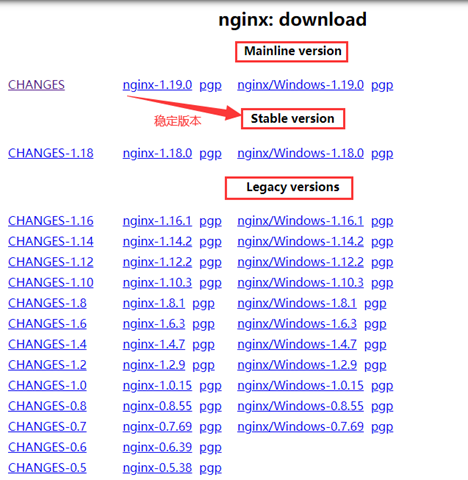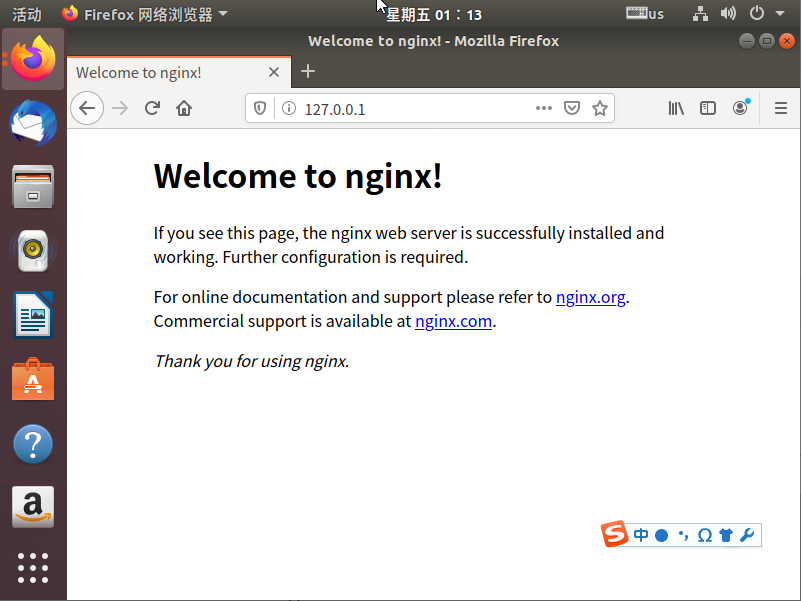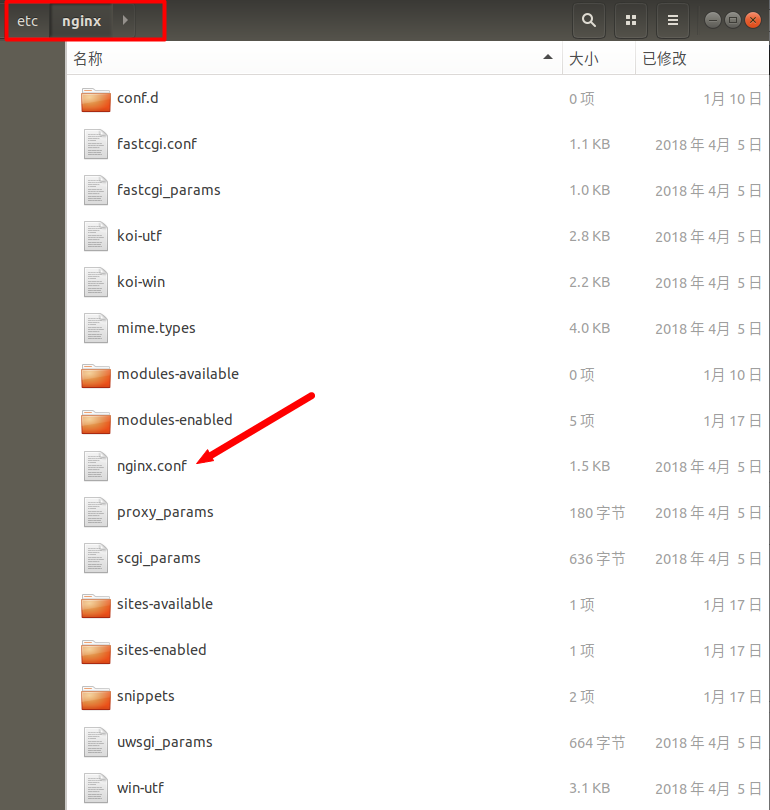How to build and configure Nginx service under Ubuntu
1. Nginx
Nginx ("engine x") is a high-performance Web and reverse proxy server developed by Russian programmer Igor Sysoev. It is also an IMAP/POP3/SMTP proxy server.
One of the three major WEB servers: apache, Nginx, lighttpd. Nginx is a good alternative and is more suitable than the Apache server when you need to handle high concurrent connections.
nginx application scenarios
Static server. (Picture, video service) Another one is lighttpd. Tens of thousands of concurrent files, html, js, css, flv, jpg, gif, etc.
Dynamic service, nginx-fastcgi mode to run PHP, jsp. (PHP concurrency is 500-1500, MySQL concurrency is 300-1500).
Reverse proxy, load balancing. If the daily pv is below 2000W, you can directly use nginx as a proxy.
Caching Service. Similar to SQUID, VARNISH.
The official website provides three versions:
The Nginx official website provides three types of versions
Mainline version: Mainline is the version that Nginx is currently working on. You can It is said to be a development version
Stable version: The latest stable version, the version recommended for production environments
Legacy versions: The stable version of the legacy old version

2 , nginx service construction
1. Use apt to install
sudo apt install nginx
2. Location after installation:
/usr/sbin/nginx: main program
/etc/nginx: Store configuration files
/usr/share/nginx: Store static files
/var/log/nginx: Store logs
3. Start and verify the effect
service nginx start # 启动nginx service nginx reload # 重新加载nginx配置文件
Enter your IP address in the browser, if Wellcome appears to nginx then the configuration is successful.
The other two commands
nginx -s reopen # 重启 Nginx nginx -s stop # 停止 Nginx

4. Check the version number:
~$ nginx -v nginx version: nginx/1.14.0 (Ubuntu)
3. Introduction to nginx configuration file

1. nginx file structure
Global block: Configure instructions that affect nginx globally. Generally, there is a user group for running the nginx server, nginx process pid storage path, log storage path, configuration file introduction, the number of worker processes allowed to be generated, etc.
events block: Configuration affects the nginx server or network connection to the user. There are the maximum number of connections per process, which event-driven model to choose to handle connection requests, whether to allow multiple network connections to be accepted at the same time, enable serialization of multiple network connections, etc.
http block: You can nest multiple servers, configure proxies, caches, log definitions and other most functions and configure third-party modules. Such as file introduction, mime-type definition, log customization, whether to use sendfile to transfer files, connection timeout, number of single connection requests, etc.
server block: Configure the relevant parameters of the virtual host. There can be multiple servers in one http.
#location block: Configure the routing of requests and the processing of various pages.
... # 全局块。配置影响nginx全局的指令。
events { # events块。配置影响nginx服务器或与用户的网络连接。
...
}
http # http块。可以嵌套多个server,配置代理,缓存,日志定义等绝大多数功能和第三方模块的配置。
{
... # http全局块
server # server块。配置虚拟主机的相关参数,一个http中可以有多个server。
{
... # server全局块
location [PATTERN] # location块。配置请求的路由,以及各种页面的处理情况。
{
...
}
location [PATTERN]
{
...
}
}
server
{
...
}
... # http全局块
}2. Default configuration
##
# You should look at the following URL's in order to grasp a solid understanding
# of Nginx configuration files in order to fully unleash the power of Nginx.
# https://www.nginx.com/resources/wiki/start/
# https://www.nginx.com/resources/wiki/start/topics/tutorials/config_pitfalls/
# https://wiki.debian.org/Nginx/DirectoryStructure
#
# In most cases, administrators will remove this file from sites-enabled/ and
# leave it as reference inside of sites-available where it will continue to be
# updated by the nginx packaging team.
#
# This file will automatically load configuration files provided by other
# applications, such as Drupal or Wordpress. These applications will be made
# available underneath a path with that package name, such as /drupal8.
#
# Please see /usr/share/doc/nginx-doc/examples/ for more detailed examples.
##
# Default server configuration
#
server {
listen 80 default_server;
listen [::]:80 default_server;
# SSL configuration
#
# listen 443 ssl default_server;
# listen [::]:443 ssl default_server;
#
# Note: You should disable gzip for SSL traffic.
# See: https://bugs.debian.org/773332
#
# Read up on ssl_ciphers to ensure a secure configuration.
# See: https://bugs.debian.org/765782
#
# Self signed certs generated by the ssl-cert package
# Don't use them in a production server!
#
# include snippets/snakeoil.conf;
root /var/www/html;
# Add index.php to the list if you are using PHP
index index.html index.htm index.nginx-debian.html;
server_name _;
location / {
# First attempt to serve request as file, then
# as directory, then fall back to displaying a 404.
try_files $uri $uri/ =404;
}
# pass PHP scripts to FastCGI server
#
#location ~ \.php$ {
# include snippets/fastcgi-php.conf;
#
# # With php-fpm (or other unix sockets):
# fastcgi_pass unix:/var/run/php/php7.0-fpm.sock;
# # With php-cgi (or other tcp sockets):
# fastcgi_pass 127.0.0.1:9000;
#}
# deny access to .htaccess files, if Apache's document root
# concurs with nginx's one
#
#location ~ /\.ht {
# deny all;
#}
}
# Virtual Host configuration for example.com
#
# You can move that to a different file under sites-available/ and symlink that
# to sites-enabled/ to enable it.
#
#server {
# listen 80;
# listen [::]:80;
#
# server_name example.com;
#
# root /var/www/example.com;
# index index.html;
#
# location / {
# try_files $uri $uri/ =404;
# }
#}3. Basic configuration of nginx
########### 每个指令必须有分号结束。#################
#user administrator administrators; #配置用户或者组,默认为nobody nobody。
#worker_processes 2; #允许生成的进程数,默认为1
#pid /nginx/pid/nginx.pid; #指定nginx进程运行文件存放地址
error_log log/error.log debug; #制定日志路径,级别。这个设置可以放入全局块,http块,server块,级别以此为:debug|info|notice|warn|error|crit|alert|emerg
events {
accept_mutex on; #设置网路连接序列化,防止惊群现象发生,默认为on
multi_accept on; #设置一个进程是否同时接受多个网络连接,默认为off
#use epoll; #事件驱动模型,select|poll|kqueue|epoll|resig|/dev/poll|eventport
worker_connections 1024; #最大连接数,默认为512
}
http {
include mime.types; #文件扩展名与文件类型映射表
default_type application/octet-stream; #默认文件类型,默认为text/plain
#access_log off; #取消服务日志
log_format myFormat '$remote_addr–$remote_user [$time_local] $request $status $body_bytes_sent $http_referer $http_user_agent $http_x_forwarded_for'; #自定义格式
access_log log/access.log myFormat; #combined为日志格式的默认值
sendfile on; #允许sendfile方式传输文件,默认为off,可以在http块,server块,location块。
sendfile_max_chunk 100k; #每个进程每次调用传输数量不能大于设定的值,默认为0,即不设上限。
keepalive_timeout 65; #连接超时时间,默认为75s,可以在http,server,location块。
upstream mysvr {
server 127.0.0.1:7878;
server 192.168.10.121:3333 backup; #热备
}
error_page 404 https://www.baidu.com; #错误页
server {
keepalive_requests 120; #单连接请求上限次数。
listen 80; #监听端口
server_name 127.0.0.1; #监听地址
location ~*^.+$ { #请求的url过滤,正则匹配,~为区分大小写,~*为不区分大小写。
#root path; #根目录
#index vv.txt; #设置默认页
proxy_pass http://mysvr; #请求转向mysvr 定义的服务器列表
deny 127.0.0.1; #拒绝的ip
allow 172.18.5.54; #允许的ip
}
}
}4. nginx virtual host configuration
#下面是server虚拟主机的配置段
server
{
listen 80;#监听端口
server_name localhost;#域名
index index.html index.htm index.php;
root /usr/local/webserver/nginx/html;#站点目录
location ~ .*\.(php|php5)?$
{
#fastcgi_pass unix:/tmp/php-cgi.sock;
fastcgi_pass 127.0.0.1:9000;
fastcgi_index index.php;
include fastcgi.conf;
}
location ~ .*\.(gif|jpg|jpeg|png|bmp|swf|ico)$
{
expires 30d;
#access_log off;
}
location ~ .*\.(js|css)?$
{
expires 15d;
#access_log off;
}
access_log off;
}Verify configuration file:
root@ubuntu: nginx -t nginx: the configuration file /etc/nginx/nginx.conf syntax is ok nginx: configuration file /etc/nginx/nginx.conf test is successful
5. nginx global variables
In order to record the client’s IP address, you can use $remote_addr and $http_x_forwarded_for
$remote_user: used to record the client user name;
$time_local: used to record the access time and time zone;
$request: used to record the URL and http protocol of the request;
$status: used to record the request status; success is 200;
$body_bytes_s ent: records the size of the body content of the file sent to the client;
$http_referer: used to record the page link accessed from;
-
$http_user_agent: Record relevant information of the client browser;
访问链接是:http://localhost:88/test1/test.php 网站路径是:/var/www/html $host:localhost $server_port:88 $request_uri:<a href="http://localhost:88/test1/test.php" rel="external nofollow" target="_blank">http:</a>//localhost:88/test1/test.php $document_uri:/test1/test.php $document_root:/var/www/html $request_filename:/var/www/html/test1/test.php
6. Nginx main configuration
1. Static Http server configuration
First of all, Nginx is an HTTP server that can display static files (such as HTML and pictures) on the server to the client through the HTTP protocol.
Configuration:
server {
listen 80; # 端口
server_name localhost 192.168.1.100; # 域名
location / { # 代表这是项目根目录
root /usr/share/nginx/www; # 虚拟目录
}
}2. Reverse proxy server configuration
What is a reverse proxy?
The client can directly access a website application server through the HTTP protocol. If the website administrator adds an Nginx in the middle, the client requests Nginx, Nginx requests the application server, and then returns the result to the client. At this time, Nginx is Reverse proxy server.

Reverse proxy configuration:
server {
listen 80;
location / {
proxy_pass http://192.168.0.112:8080; # 应用服务器HTTP地址
}
}既然服务器可以直接HTTP访问,为什么要在中间加上一个反向代理,不是多此一举吗?反向代理有什么作用?继续往下看,下面的负载均衡、虚拟主机,都基于反向代理实现,当然反向代理的功能也不仅仅是这些。
3、负载均衡配置
当网站访问量非常大,也摊上事儿了。因为网站越来越慢,一台服务器已经不够用了。因此,可以将同一应用部署在多台服务器上,以将众多用户请求分配至多台机器进行处理。即使其中一台服务器故障,只要其他服务器正常运行,用户仍然可以正常使用,这是多台服务器带来的好处。Nginx可以通过反向代理来实现负载均衡。

负载均衡配置:
upstream myapp {
server 192.168.0.111:8080; # 应用服务器1
server 192.168.0.112:8080; # 应用服务器2
}
server {
listen 80;
location / {
proxy_pass http://myweb;
}
}4、虚拟主机配置
有的网站访问量大,需要负载均衡。然而并不是所有网站都如此出色,有的网站,由于访问量太小,需要节省成本,将多个网站部署在同一台服务器上。
例如将www.aaa.com和www.bbb.com两个网站部署在同一台服务器上,两个域名解析到同一个IP地址,但是用户通过两个域名却可以打开两个完全不同的网站,互相不影响,就像访问两个服务器一样,所以叫两个虚拟主机。
虚拟主机配置:
server {
listen 80 default_server;
server_name _;
return 444; # 过滤其他域名的请求,返回444状态码
}
server {
listen 80;
server_name www.aaa.com; # www.aaa.com域名
location / {
proxy_pass http://localhost:8080; # 对应端口号8080
}
}
server {
listen 80;
server_name www.bbb.com; # www.bbb.com域名
location / {
proxy_pass http://localhost:8081; # 对应端口号8081
}
}在服务器8080和8081分别开了一个应用,客户端通过不同的域名访问,根据server_name可以反向代理到对应的应用服务器。
虚拟主机的原理是通过HTTP请求头中的Host是否匹配server_name来实现的,有兴趣的同学可以研究一下HTTP协议。
另外,server_name配置还可以过滤有人恶意将某些域名指向你的主机服务器。
The above is the detailed content of How to build and configure Nginx service under Ubuntu. For more information, please follow other related articles on the PHP Chinese website!

Hot AI Tools

Undresser.AI Undress
AI-powered app for creating realistic nude photos

AI Clothes Remover
Online AI tool for removing clothes from photos.

Undress AI Tool
Undress images for free

Clothoff.io
AI clothes remover

Video Face Swap
Swap faces in any video effortlessly with our completely free AI face swap tool!

Hot Article

Hot Tools

Notepad++7.3.1
Easy-to-use and free code editor

SublimeText3 Chinese version
Chinese version, very easy to use

Zend Studio 13.0.1
Powerful PHP integrated development environment

Dreamweaver CS6
Visual web development tools

SublimeText3 Mac version
God-level code editing software (SublimeText3)

Hot Topics
 1663
1663
 14
14
 1419
1419
 52
52
 1313
1313
 25
25
 1264
1264
 29
29
 1237
1237
 24
24
 How to configure nginx in Windows
Apr 14, 2025 pm 12:57 PM
How to configure nginx in Windows
Apr 14, 2025 pm 12:57 PM
How to configure Nginx in Windows? Install Nginx and create a virtual host configuration. Modify the main configuration file and include the virtual host configuration. Start or reload Nginx. Test the configuration and view the website. Selectively enable SSL and configure SSL certificates. Selectively set the firewall to allow port 80 and 443 traffic.
 How to start containers by docker
Apr 15, 2025 pm 12:27 PM
How to start containers by docker
Apr 15, 2025 pm 12:27 PM
Docker container startup steps: Pull the container image: Run "docker pull [mirror name]". Create a container: Use "docker create [options] [mirror name] [commands and parameters]". Start the container: Execute "docker start [Container name or ID]". Check container status: Verify that the container is running with "docker ps".
 How to check the name of the docker container
Apr 15, 2025 pm 12:21 PM
How to check the name of the docker container
Apr 15, 2025 pm 12:21 PM
You can query the Docker container name by following the steps: List all containers (docker ps). Filter the container list (using the grep command). Gets the container name (located in the "NAMES" column).
 How to check whether nginx is started
Apr 14, 2025 pm 01:03 PM
How to check whether nginx is started
Apr 14, 2025 pm 01:03 PM
How to confirm whether Nginx is started: 1. Use the command line: systemctl status nginx (Linux/Unix), netstat -ano | findstr 80 (Windows); 2. Check whether port 80 is open; 3. Check the Nginx startup message in the system log; 4. Use third-party tools, such as Nagios, Zabbix, and Icinga.
 How to create containers for docker
Apr 15, 2025 pm 12:18 PM
How to create containers for docker
Apr 15, 2025 pm 12:18 PM
Create a container in Docker: 1. Pull the image: docker pull [mirror name] 2. Create a container: docker run [Options] [mirror name] [Command] 3. Start the container: docker start [Container name]
 How to check nginx version
Apr 14, 2025 am 11:57 AM
How to check nginx version
Apr 14, 2025 am 11:57 AM
The methods that can query the Nginx version are: use the nginx -v command; view the version directive in the nginx.conf file; open the Nginx error page and view the page title.
 How to configure cloud server domain name in nginx
Apr 14, 2025 pm 12:18 PM
How to configure cloud server domain name in nginx
Apr 14, 2025 pm 12:18 PM
How to configure an Nginx domain name on a cloud server: Create an A record pointing to the public IP address of the cloud server. Add virtual host blocks in the Nginx configuration file, specifying the listening port, domain name, and website root directory. Restart Nginx to apply the changes. Access the domain name test configuration. Other notes: Install the SSL certificate to enable HTTPS, ensure that the firewall allows port 80 traffic, and wait for DNS resolution to take effect.
 What to do if nginx server is hung
Apr 14, 2025 am 11:42 AM
What to do if nginx server is hung
Apr 14, 2025 am 11:42 AM
When the Nginx server goes down, you can perform the following troubleshooting steps: Check that the nginx process is running. View the error log for error messages. Check the syntax of nginx configuration. Make sure nginx has the permissions you need to access the file. Check file descriptor to open limits. Confirm that nginx is listening on the correct port. Add firewall rules to allow nginx traffic. Check reverse proxy settings, including backend server availability. For further assistance, please contact technical support.




